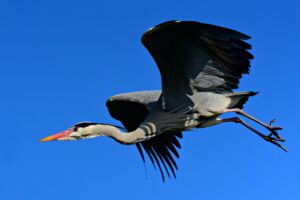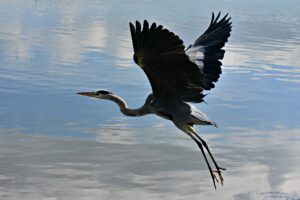North America’s largest Heron
You may have noticed that we’re pretty fond of the Great Blue Heron. These water fowl are beautiful and majestic, but equally important, they live near the water. Like many of us, these dignified wading birds depend upon this river for their survival.
 Highly adaptable, these birds range all across North America, and are as home in southern Alaska as they are her in Florida.
Highly adaptable, these birds range all across North America, and are as home in southern Alaska as they are her in Florida.
Stealthy Hunters
These birds feed by wading into waters, and waiting for prey to swim close. Then with a thrust of their sturdy bills, they capture prey. They also forage on land, hunt from floating objects, and stalk prey in grasslands.
Like the Anhinga and Cormorant they eat mostly fish, but also frogs, salamanders, turtles, snakes, rodents and other birds.
Social Life
 These birds breed in colonies, often nesting with other birds. They nest higher up in trees, usually 20 to 60 feet up in the air, but sometimes lower or on the ground on predator free islands. The males choose a nesting site and puts on a display there to attract a mate. Displays include flying above the colony with its neck extended, and stretching its neck out with its bill pointed upward. Hey, this is exciting to lady herons!
These birds breed in colonies, often nesting with other birds. They nest higher up in trees, usually 20 to 60 feet up in the air, but sometimes lower or on the ground on predator free islands. The males choose a nesting site and puts on a display there to attract a mate. Displays include flying above the colony with its neck extended, and stretching its neck out with its bill pointed upward. Hey, this is exciting to lady herons!
And when it comes to nesting, it’s a team effort. The female (mostly) builds the nest, but the male (mostly) gathers the materials. And when mama lays 2-7 light blue eggs, the pair take turns keeping the eggs warm and protected. And both parents feed their young, regurgitating food for about two months while the young chicks mature to independence.
They rely on us
 Keeping these beautiful birds close to our shores and in our neighborhoods depends on their being able to feed and nest there. Healthy springs provide the right type of habitat. Habitat restoration has an almost immediate impact on fish species present in the restoration area, with increases in numbers and diversity occurring over just a few years. We can ensure that these and other species have a home close to us by caring for our waters, and returning them to having the rich diversity that they had for years. You can help by keeping their habitat in your thoughts, sharing those thoughts with your friends and acquaintances, and supporting our restoration efforts.
Keeping these beautiful birds close to our shores and in our neighborhoods depends on their being able to feed and nest there. Healthy springs provide the right type of habitat. Habitat restoration has an almost immediate impact on fish species present in the restoration area, with increases in numbers and diversity occurring over just a few years. We can ensure that these and other species have a home close to us by caring for our waters, and returning them to having the rich diversity that they had for years. You can help by keeping their habitat in your thoughts, sharing those thoughts with your friends and acquaintances, and supporting our restoration efforts.
Please share this article and all of our information with your friends and neighbors. Become one of our flock.
